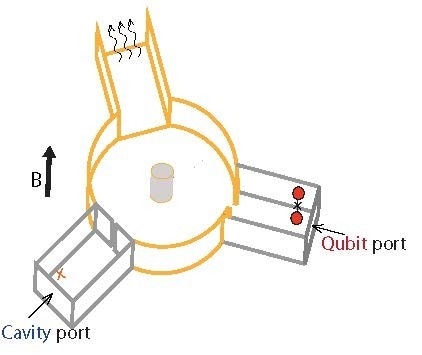Researchers at the University of Massachusetts Amherst and collaborators from the University of Chicago have modified a microwave circulator to be used in quantum computing. This is the first time that the precise degree of nonreciprocity between a qubit - the basic building block of quantum computing - and a microwave-resonant cavity has been precisely tuned. Science Advances published the research.

The nonreciprocal device has a circulator (center), qubit port, superconducting cavity, and output port. Image Credit: University of Massachusetts Amherst
In quantum information processing, the capacity to precisely tune the degree of nonreciprocity is a valuable tool. By doing this, scientists derived a broad and generally applicable theory that builds on previous understandings of nonreciprocity while simplifying it enough that future research on related subjects can benefit from the team's model, even when utilizing different parts and platforms.
Quantum computing fundamentally diverges from bit-based computing, ubiquitous in daily activities. A bit, typically denoted as either 0 or 1, represents information and is the foundation for all software, websites, and emails.
In contrast, the “quantum superposition” of two states of a quantum object serves as the representation for “quantum bits,” or “qubits,” which are similar to regular bits in the context of quantum computing. Qubits are not limited to 0s or 1s because matter behaves differently in a quantum state.
A characteristic known as “nonreciprocity” may open up new possibilities for quantum computing to take advantage of the possibilities presented by the quantum world.
Imagine a conversation between two people. Total reciprocity is when each of the people in that conversation is sharing an equal amount of information. Nonreciprocity is when one person is sharing a little bit less than the other.
Sean van Geldern, Graduate Student and Study Author, Department of Physics, University of Massachusetts Amherst
“This is desirable in quantum computing, because there are many computing scenarios where you want to give plenty of access to data without giving anyone the power to alter or degrade that data,” says Chen Wang, Senior Author and Assistant Professor of Physics at UMass Amherst.
Lead author Ying-Ying Wang, a Graduate Student in Physics at UMass Amherst, along with her co-authors, conducted a series of simulations to ascertain the necessary design and properties of their circulator to control nonreciprocity. Then, they constructed their circulator and conducted several tests to clarify how precisely their gadget allowed nonreciprocity, as well as to validate their theory.
By doing this, they could reduce their model's 16 parameters - which described how to construct their particular device - to a more straightforward and universal model with just six parameters.
Compared to the original, more specific model, this revised, more generalized model is much more useful because it can be broadly applied to future research initiatives.
The team's "integrated nonreciprocal device" has a "Y"-like appearance. The circulator, which acts as a traffic circle for the microwave signals mediating the quantum interactions, is located in the middle of the "Y." The cavity port, a resonant superconducting cavity with an electromagnetic field hosted within, is one of the legs. The qubit, printed on a sapphire chip, is held in place by another leg of the "Y." The output port is the last leg.
If we vary the superconducting electromagnetic field by bombarding it with photons, we see that that qubit reacts in a predictable and controllable way, which means that we can adjust exactly how much reciprocity we want. And the simplified model that we produced describes our system in such a way that the external parameters can be calculated to tune an exact degree of nonreciprocity.
Ying-Ying Wang, Study Lead Author and Graduate Student, Department of Physics, University of Massachusetts Amherst
Chen Wang said, “This is the first demonstration of embedding nonreceptivity into a quantum computing device, and it opens the door to engineering more sophisticated quantum computing hardware.”
The American Department of Energy, the Army Research Office, the Simons Foundation, the Air Force Office of Scientific Research, the American National Science Foundation, and the Laboratory for Physical Sciences Qubit Collaboratory all contributed funding to this study.
Journal Reference:
Wang, Y., et al. (2024) Dispersive nonreciprocity between a qubit and a cavity. Science Advances. doi.org/10.1126/sciadv.adj8796